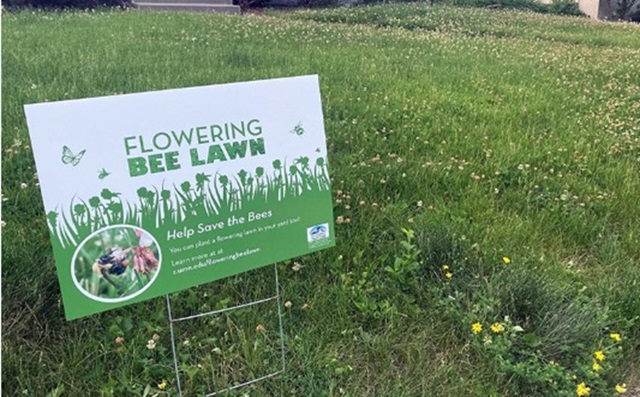LIVING HERE
Have you ever heard of a bee lawn?
Our food crops, such as tree fruits, pumpkins, and countless others, depend on wild bees and other pollinators. Bee lawns are a new grass alternative that is lower-maintenance, drought-tolerant, and pollinator-friendly. They combine low-growing flowers with grass seeds. They attract bees by giving them what they like. These flowering lawns embrace a blend of wildflowers and even plants others consider weeds, such as clover and dandelions. Traditional turf grass lawns come with serious costs to the environment (not to mention your time and bank account) by requiring frequent mowing, watering, herbicides, and fertilizer to thrive. However, ditching your lawn is a big step with many benefits for everyone.
Bee lawns provide an eco-friendly option for folks who aren’t quite ready to give up their grass. Bee lawns are great for pollinators and they’ve been found to attract over 50 species of bees and support a higher diversity of bees than lawns with clover alone. The benefits of bee lawns extend beyond pollinators, however. Bee lawns require fewer inputs (water, mowing, fertilizer, and pesticides) than traditional lawns.
Before installing any lawn alternative, check the local rules. Because bee lawn seed is such a new product, you might have trouble finding it at your local garden center. If it isn’t on their shelves yet, check with your local seed companies. They will likely have seed mixes tailored for your local conditions. If they don’t carry bee lawn seed, it can be purchased from online companies. Make sure to check the planting recommendations for the seed mix you purchase. Bee lawn seed that contains fine fescue grass needs to be planted in either the spring or fall when growing conditions are cool. Spring is a great time to plant if you want immediate results.
While you can remove existing turf before seeding a bee lawn, it’s not necessary in most situations. Instead, try over-seeding which is a great option because it’s so much easier both in the sense of the amount of effort you have to put in and making it cost effective. To over-seed, simply mow your lawn as low as possible, rake the clippings, scatter the seed into your existing lawn, and then lightly rake the seed into the soil. One of the best parts about bee lawns is how easy they are to maintain. Bee lawns only need to be mowed two to four times per year because they grow slower than traditional lawns.
Overall, bee lawns are a lower-maintenance alternative to traditional lawns. They provide food for pollinators, reduce your environmental footprint, and add color to your yard.









